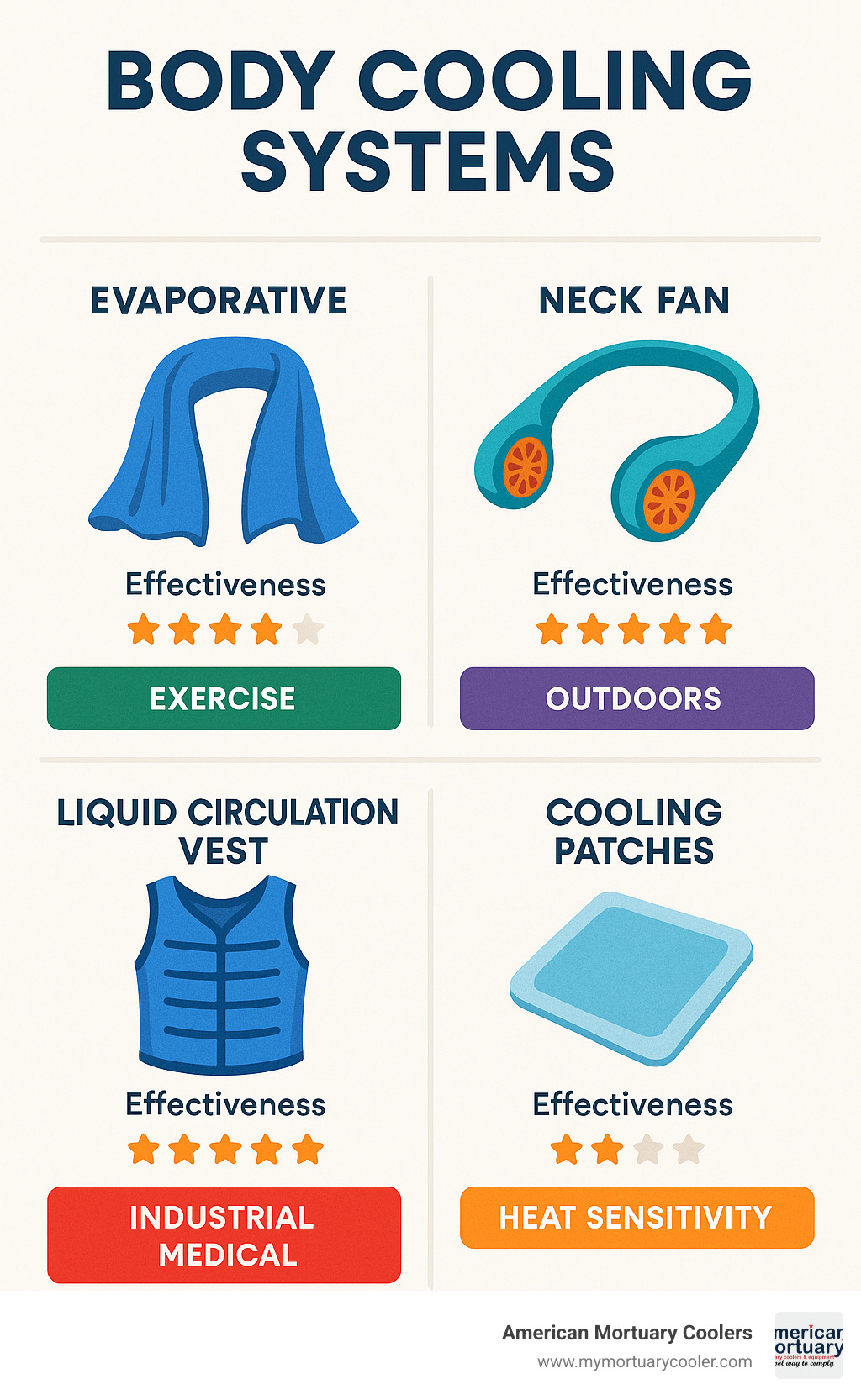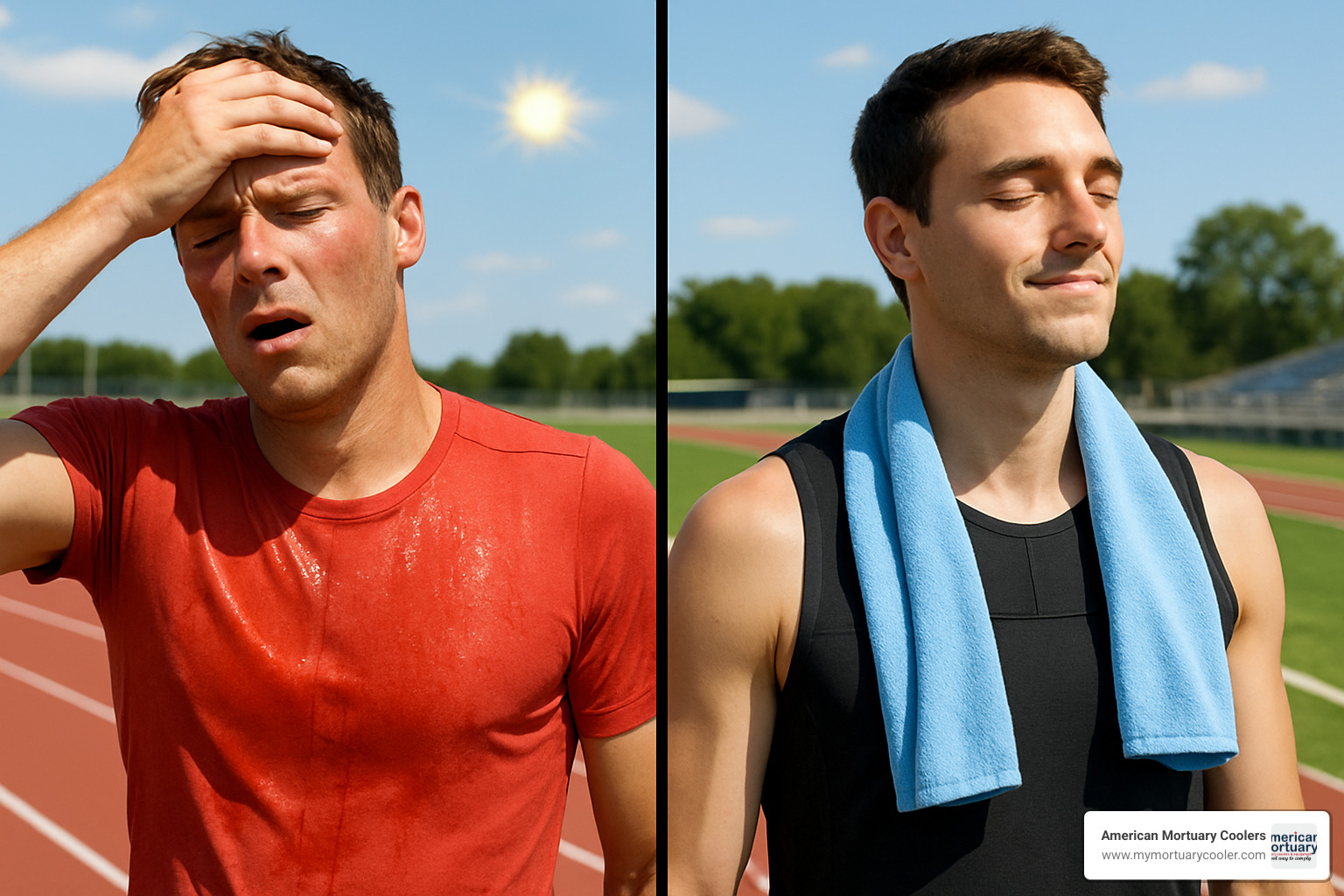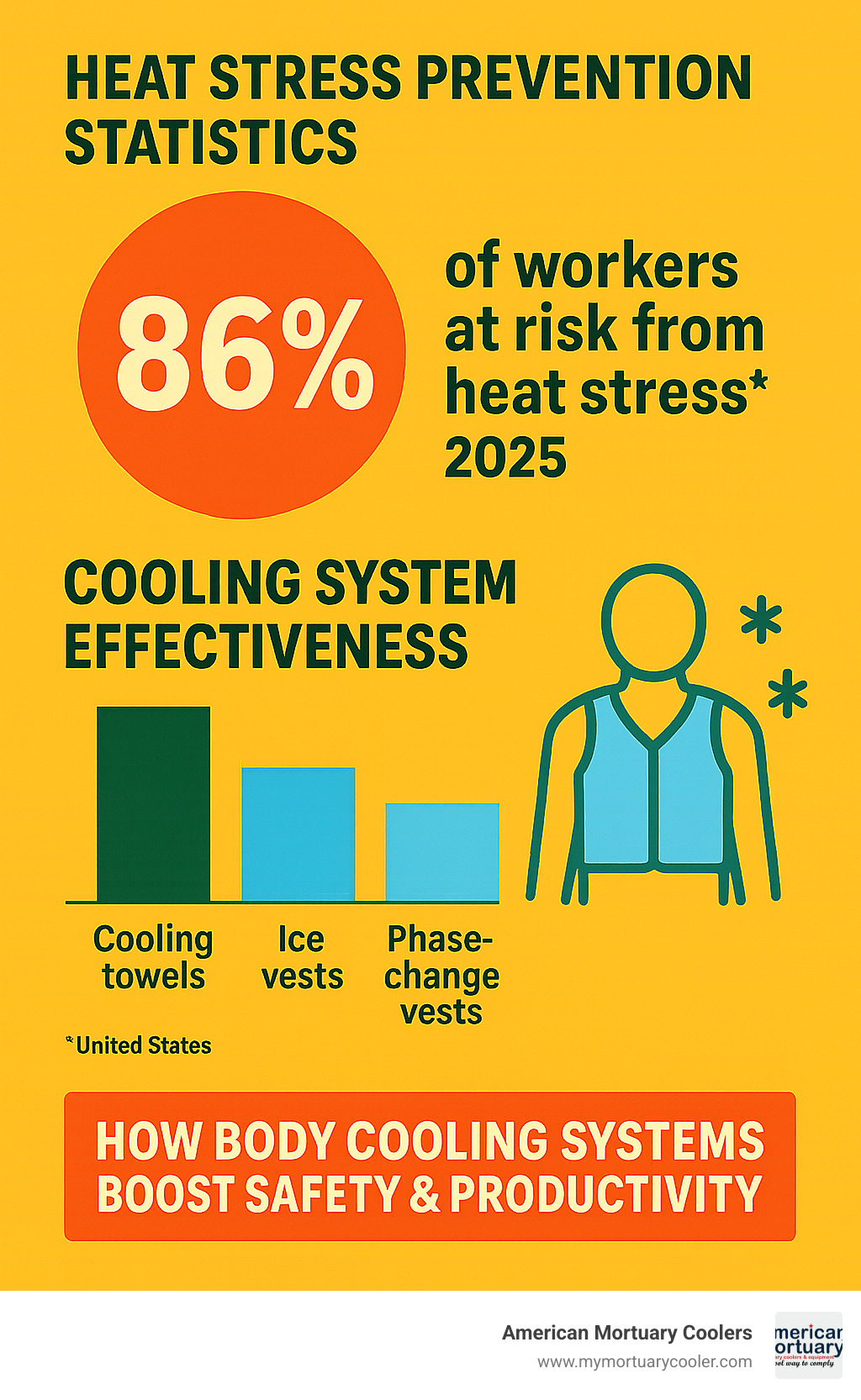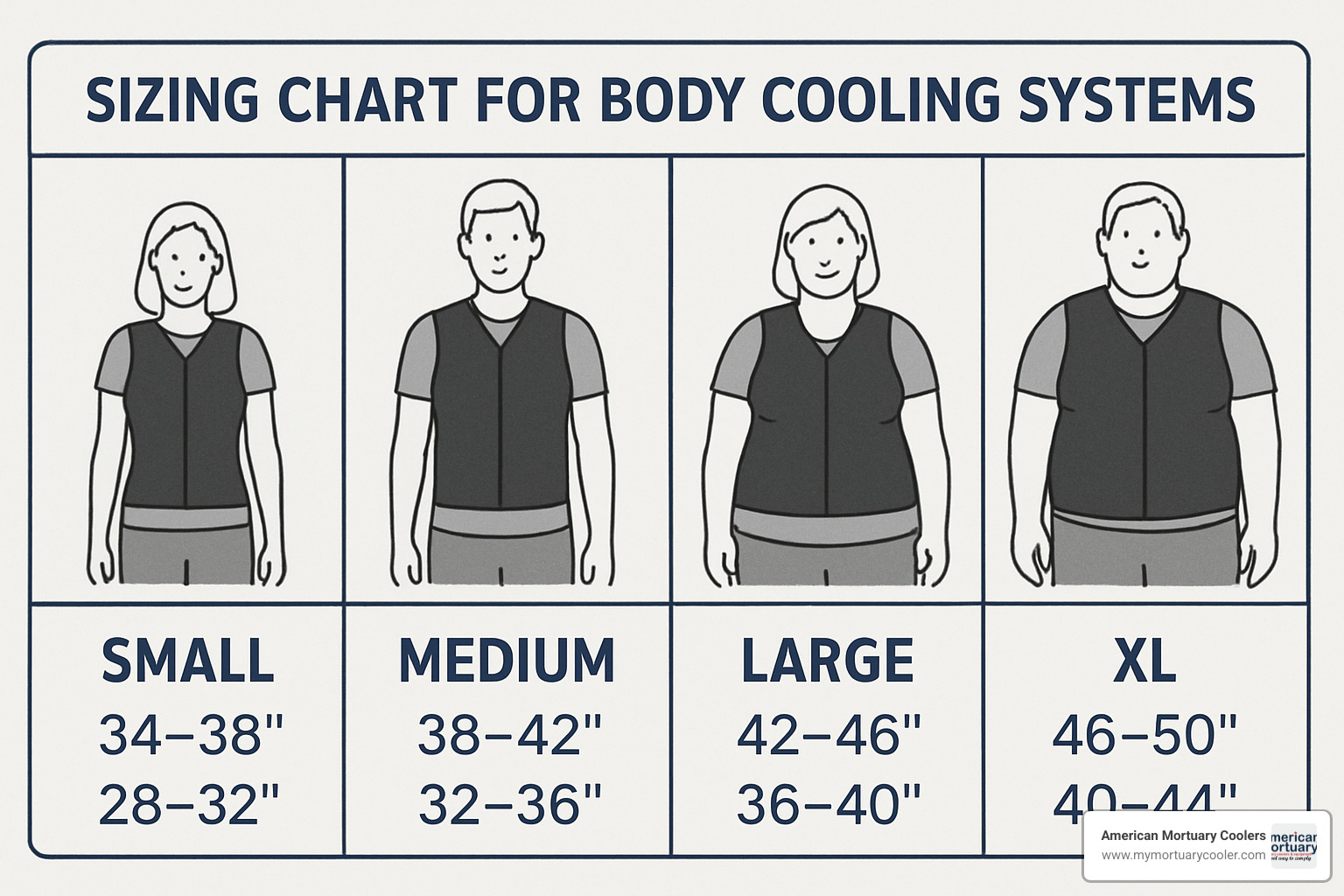
The Complete Guide to Body Cooling Systems: How to Cool Your Body
Why Body Cooling Systems Are Essential for Health and Safety
A body cooling system is any method or device designed to help lower your core body temperature and prevent overheating. These systems work by enhancing your body's natural cooling processes through evaporation, air circulation, or direct cooling contact.
Quick Answer - Body Cooling Systems Overview:
- What they are: Devices that help regulate body temperature through cooling towels, fans, vests, or liquid circulation
- How they work: Improve natural cooling via evaporation, airflow, or direct heat transfer
- Main types: Evaporative (cooling towels), active airflow (neck fans), liquid circulation (cooling vests)
- Key benefits: Prevent heat exhaustion, improve performance, reduce fatigue
- Best for: Athletes, outdoor workers, people with heat-sensitive conditions
Heat stress affects millions of workers and athletes every year. Your body naturally cools itself through sweating and blood vessel dilation, but in extreme heat or during intense activity, these mechanisms aren't always enough. Modern body cooling systems bridge this gap using everything from NASA-inspired liquid circulation technology to simple evaporative fabrics.
The cooling industry has exploded in recent years, with products like the Sukeen cooling towel earning over 24,000 customer reviews and the JISULIFE neck fan selling 30,000+ units monthly.
I'm Mortuary Cooler, a national-level mortuary cooler supplier with experience in temperature control systems. My expertise in body cooling system technology extends from specialized mortuary applications to understanding how effective cooling solutions can improve safety and performance across industries.

Related content about body cooling system:
Understanding Body Cooling Systems
Your body is like a high-performance engine that constantly generates heat. Every heartbeat, muscle contraction, and metabolic process creates heat that needs to be expelled. Without effective cooling, your internal temperature would climb to dangerous levels quickly.
Your body's natural thermoregulation system works through sweat evaporation and conductive cooling by moving warm blood closer to your skin surface. But even this sophisticated system has limits. Research shows that heat tolerance without active cooling ranges from 30 to 60 minutes before experiencing fatigue, headaches, and nausea.

What Is a Body Cooling System?
A body cooling system is any tool that helps your natural cooling abilities when heat gets intense. These systems break down into passive vs active solutions. Passive cooling systems like cooling towels work without power, using physics and natural processes. Active cooling systems use batteries or power to provide stronger, more consistent cooling through fans or liquid circulation.
How Does a Body Cooling System Work Inside the Body?
Your hypothalamus acts like a thermostat, monitoring core temperature and triggering vasodilation - expanding blood vessels near the skin to increase heat transfer. Simultaneously, sweat glands produce moisture that removes heat through evaporation.
But high humidity, intense activity, or dehydration can overwhelm these natural systems. External body cooling systems provide additional cooling power precisely when your natural mechanisms are pushed beyond their limits.
Main Types of Body Cooling Products & How They Compare
When shopping for a body cooling system, you'll find options ranging from simple towels to high-tech liquid circulation systems. Each type serves specific purposes - choosing the right one depends on your needs and environment.
Evaporative & Phase-Change Body Cooling Systems
Evaporative cooling systems work with your body's natural processes. Cooling towels like the Sukeen 4-pack (24,000+ reviews, 4.5-star rating) are made from specialized microfiber that holds water while maximizing evaporation. The FROGG TOGGS Chilly Pad offers similar performance with 12,700+ reviews.
Ice neck wraps and cooling tubes target pulse points where blood vessels run close to skin. Phase-change material (PCM) inserts absorb massive amounts of heat as they change from solid to liquid, maintaining steady temperatures for 2-4 hours using the same technology found in spacecraft.
Evaporative systems excel in reliability - no moving parts or electronics to fail. Their limitation is high humidity, where saturated air slows evaporation.
Active Airflow & Liquid-Circulation Body Cooling Systems
Active cooling systems require power but deliver superior performance. Wearable fans like the JISULIFE Portable Neck Fan (51,000+ reviews, 30,000+ monthly sales) provide continuous airflow for 4-25 hours depending on speed settings.
Liquid circulation vests represent premium cooling technology, originally developed for astronauts and military pilots. These systems circulate chilled water through embedded tubing. Compressed air cooling systems like Vortec Cooling Vests use pneumatic technology to generate cold air without electricity.
The Embr Wave uses thermoelectric technology to deliver precise thermal sensations to your wrist, triggering natural temperature regulation responses.
Active systems provide consistent, controllable cooling regardless of humidity but require power and maintenance.
Benefits and Use Cases: Health, Comfort, Performance
Body cooling systems deliver benefits far beyond simple comfort. Heat stroke prevention is critical - when core temperature climbs too high, your body starts dangerous reactions that can lead to complete cooling system shutdown. Maintaining temperature below critical thresholds prevents this life-threatening progression.

Athletes report reduced perceived exertion - they don't feel like they're working as hard while maintaining the same intensity. Recovery happens faster when muscles aren't stressed by overheating.
For more information about temperature control in specialized environments, see our guide on mortuary cooling systems and why temperature matters.
How Body Cooling Systems Boost Safety & Productivity
Heat-related injuries cost employers millions annually. Effective cooling drops heart rate significantly during heat stress, allowing your cardiovascular system to focus on delivering oxygen to working muscles rather than cooling. Mental clarity stays sharp too - heat stress impairs decision-making ability.
OSHA compliance becomes manageable when proactively addressing heat stress. Some cooling vests meet specific safety certifications like NFPA 70E arc flash ratings.
Condition-Specific Relief: Heat Stress, MS, Menopause
Multiple sclerosis patients often experience severe heat intolerance that triggers symptom flares. Specialized cooling vests help maintain independence and daily activities. Menopause-related hot flashes benefit from targeted cooling like the Embr Wave bracelet, providing discreet relief.
Core cooling therapy gains medical recognition as healthcare providers see real benefits. Some systems qualify for FSA/HSA reimbursement, reflecting their therapeutic value.
Buying Guide: Choosing the Right Body Cooling System
Finding the perfect body cooling system comes down to understanding your specific needs. Consider your activity level first - light activities might need only a cooling towel, while intense physical work requires serious cooling power.

Your environment matters - high humidity makes evaporative cooling less effective. Budget should consider ongoing costs like batteries and maintenance. Battery life varies dramatically between power settings. Proper size and fit prevents chafing and ensures effective heat transfer.
Matching Products to Sports & Outdoor Work
Runners and cyclists need lightweight options that won't restrict movement - cooling towels or small fans work well. Construction crews and landscapers need heavy-duty systems that handle abuse, like cooling vests with swappable ice packs or liquid circulation systems.
Racing teams use compact systems that work around safety equipment while delivering professional-grade cooling power in tight spaces.
Special Considerations for Kids, Elderly, Medical Users
Kids don't always recognize overheating and need gentle cooling with safety features. Elderly users often take medications affecting heat response and need controllable, gentle cooling. Medical users should consult doctors before using cooling systems, as conditions like heart problems or diabetes can change how bodies respond to cooling.
Price Ranges, Maintenance & Safety Tips
Budget options ($5-$50) include cooling towels and basic fans. Mid-range systems ($50-$300) offer better performance with advanced fans and cooling vests. Professional-grade equipment ($300-$3,000+) provides maximum cooling power.
Maintenance is straightforward - clean evaporative products regularly, practice smart charging habits for battery systems, and follow manufacturer guidelines for duration and temperature limits.
Top-Rated Products & Emerging Innovations
The Sukeen 4-pack cooling towel leads with 24,000+ reviews and 4.5-star rating. These 40"x12" microfiber towels activate instantly with water and deliver reliable performance.
The JISULIFE Portable Neck Fan represents new-generation wearable cooling with 51,000+ reviews. Its 4000mAh battery provides 4-25 hours of continuous airflow in a hands-free design.
The FROGG TOGGS Chilly Pad maintains 12,700+ reviews and 4.5-star rating through consistent performance. The Embr Wave offers precision thermoelectric cooling at your wrist, triggering natural cooling responses.
Best-Seller Snapshot & Customer Ratings
Successful body cooling systems share three traits: immediate effectiveness, reasonable duration, and simple operation. The MISSION Cooling Performance Hat (12,800+ reviews, 4.3-star rating) and Ergodyne Chill Its 6700 Cooling Bandana (9,000+ reviews, 4.0-star rating) prove customers prioritize instant relief and all-day performance.
Customers pay more for proven performance - premium products with strong review histories often outsell cheaper alternatives.
What's Next in Body Cooling Technology?
Phase-change nanomaterials promise cooling vests that stay active 8+ hours while weighing half as much as current models. Wearable air conditioning is moving from concept to reality with miniaturized refrigeration systems.
Smart technology integration uses IoT sensors to monitor body temperature and automatically adjust cooling intensity. Graphene and advanced materials offer superior thermal conductivity in lighter packages. AI and machine learning will learn personal preferences and automatically optimize comfort.
Frequently Asked Questions about Body Cooling Systems
Do body cooling systems really lower core temperature?
Yes! Effective body cooling systems measurably reduce core body temperature. Liquid circulation systems lower core temperature by 2-4°F, while evaporative systems provide 1-2°F reduction. Even small temperature drops dramatically improve comfort and performance while maintaining safe ranges during heat exposure.
Can I use a body cooling system with medication or medical devices?
Consult your healthcare provider first. Some medications affect temperature regulation or skin sensitivity. Cardiovascular medications, diabetes treatments, and neurological drugs might interact with cooling therapies. Medical devices like pacemakers or insulin pumps may have temperature limitations. Many cooling systems qualify for FSA/HSA coverage as therapeutic equipment.
How long do cooling towels and neck fans stay effective?
Cooling towels provide 2-3 hours of cooling in typical conditions, longer in dry environments but shorter in high humidity. They reactivate easily with water. Neck fans provide consistent cooling for 4-25+ hours depending on battery capacity and speed settings, maintaining steady performance until the battery dies.
Conclusion
Finding the right body cooling system can change your life - whether battling heat waves, pushing through workouts, or managing heat-sensitive medical conditions. Today's options range from simple $10 evaporative towels to sophisticated liquid circulation systems.
The key is matching the system to your needs. Runners and weekend warriors often find cooling towels and compact fans perfect. Construction crews and outdoor workers need heavy-duty ice pack vests and liquid circulation systems for safety and productivity.
At American Mortuary Coolers, our years perfecting temperature control for demanding applications taught us that the best cooling system is the one that actually gets used. Simple solutions often work amazingly well for most people.
For deeper technical insights, check out The Ultimate Guide to Effective Body Cooling Solutions.

Heat doesn't have to win. Whether dealing with medical heat sensitivity, working in brutal conditions, or wanting to enjoy summer comfortably, there's a body cooling system for you. Start simple, stay safe, and remember - the best cooling system keeps you comfortable, healthy, and doing what you love.



